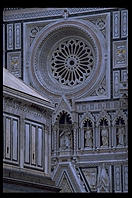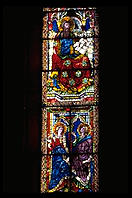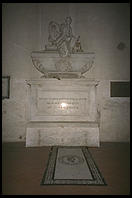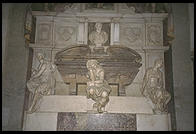
Churches
of Florence by Philip Greenspun; created 1995

This cathedral, the tallest building in the city, is remarkable for its elaborately decorated exterior and starkly bare interior, just the reverse of most cathedrals. White, green, and pink Tuscan marble adorns the outside walls. You really must climb up to to the top of the dome for the views of Vasari's Last Judgment frescoes and of the city frm the top.
The adjacent Baptistry is famous for its bronze doors and ceiling mosaic. It was used for baptizing infants who were then carried into the cathedral.
When I first came to Italy in 1983, I figured that "Duomo" meant "dome" in
Latin or something. I was puzzled to find several churches with no domes referred
to as "Il Duomo." It turns out that "Duomo" comes from the Latin Domus Dei
or "House of God."

 If the line to get
into the Uffizi is too long, walk east a few blocks to the Piazza di Santa Croce.
The Gothic church itself is impressive, but the tombs are what make this such a
great place to nourish an inferiority complex. Rossini and Michelangelo are
buried here. Dante died in exile in 1321 but a monument was built here in his
honor in 1829. Galileo was excommunicated by the Church in 1633 but permitted a
Christian burial here in 1737, nearly 100 hundred years after his death in
1642.
If the line to get
into the Uffizi is too long, walk east a few blocks to the Piazza di Santa Croce.
The Gothic church itself is impressive, but the tombs are what make this such a
great place to nourish an inferiority complex. Rossini and Michelangelo are
buried here. Dante died in exile in 1321 but a monument was built here in his
honor in 1829. Galileo was excommunicated by the Church in 1633 but permitted a
Christian burial here in 1737, nearly 100 hundred years after his death in
1642.
If you aren't impressed by the bones of great men, some of their works are on
display here as well. The last chapel on the right as you enter contains a 1338
fresco by Taddeo Gaddi of an angel appearing to shepherds, the first depiction of
a night scene in that medium. There is also a famous crucifix by Donatello,
frescoes by Giotto, and the Capella de' Pazzi next door in the
cloister.
After you've finished with the church, walk three blocks to the Bar Vivoli Gelateria, Via Isola delle Stinche 7. You can get a snack here, but they are famous for their gelato. If you're really hungry, an excellent and very friendly trattoria is just at the other side of the square from the church and to the right (more or less on your way to Bar Vivoli): La Maremmana, Via de'Macc 77r, tel 24 12 26. I got out of there for 21,000 lire.
Just a couple of blocks east of the Galleria dell'Accademia, this church contains an important 13th century painting of the Madonna. It was started by a monk and finished by an angel. The Eyewitness guide says that "many newlywed couples traditionally come here after their wedding ceremony to present a bouquet of flowers to the Virgin and pray for a long and fruitful marriage."